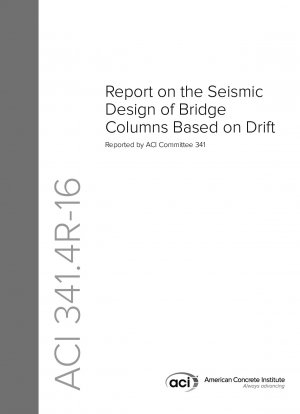ACI 341.4R-2016
Report on the Seismic Design of Bridge Columns Based on Drift
- Standard No.
- ACI 341.4R-2016
- Release Date
- 2016
- Published By
- ACI - American Concrete Institute
- Latest
- ACI 341.4R-2016
- Scope
- Current design practice@ as reflected in Caltrans (2013) and AASHTO (2013)@ makes use of force-based design approaches. These approaches@ which reduce elastic design forces by a factor to account for the intended ductile response of critical bridge components@ have been used for many years. More recently@ displacement-based design approaches@ such as outlined by AASHTO (2011)@ have been advocated for performance-based seismic design. While promising@ displacement-based design approaches do not have the support of decades of validation in the field. Uncertainty exists in estimates of demands and capacities@ and at present it is difficult to implement a comprehensive treatment of uncertainty in routine design practice. Therefore@ a deterministic approach for displacement-based seismic design is described herein. This approach is intended to more reliably achieve intended performance objectives than can be achieved with other approaches@ and augments existing tools available to designers. The approach is developed in terms of performance objectives and associated column drift levels. Because embankment flexibility can have a significant effect on drift demands in the columns of ordinary bridges having one or several spans@ a method to consider this effect is presented. The sensitivity of computed response to design and modeling assumptions is illustrated by example. Column deformation capacity at any performance limit is dependent on the amount of longitudinal and transverse reinforcement@ material properties@ geometry and boundary conditions@ and loading history. Experimental tests indicate substantial variability in the deformation capacities associated with discrete performance limits (damage states). Combined loading??for example@ bending moment combined with axial force and torsion??further influences drift capacity (Prakash et al. 2010). Typical design approaches have relied on point estimates to compare capacity and demand. They are referred to as deterministic design approaches. Point estimates are single value estimates of values that have a statistical distribution. Recognizing the significant uncertainty in both demands and capacities@ alternative approaches would establish an adequate level of confidence that demands do not exceed capacities at a specified hazard level. They might also seek to provide an acceptably small mean annual frequency of demands exceeding capacities. However@ many challenges remain in adequately defining seismic hazard@ site conditions@ structural properties@ and component hysteretic behavior@ including component deformation capacities@ to fulfill the theoretical potential of performance-based design. Furthermore@ addressing these uncertainties in the context of realistic limitations in design practice presents a formidable challenge. This document considers point estimates of demands and capacities. Performance limits well short of collapse are considered@ thereby providing a reserve margin. Drift is the index used to compare capacity and demand as it is a direct measure of bridge performance@ unambiguous@ and easily identified. Performance states are established as a function of limiting drift demands for a range of transverse steel content relevant to practice. Only rectangular and circular solid@ not hollow@ reinforced concrete (RC) column sections are considered. Transverse reinforcement content can be varied within limits to affect drift capacity@ thereby allowing the design approach to be used over regions of varied seismic hazard. Relatively little experimental data are available on the performance of columns made with highstrength concrete. One example is compressive strengths greater than 8000 psi (55 MPa). The drift capacity estimates made herein@ therefore@ are for concrete strengths less than 8000 psi (55 MPa)@ a strength range commonly used by most State Departments of Transportation. Methods for evaluating drift demands are described@ with emphasis on consideration of embankment response@ which can be significant for common short-span bridges. Where conventional force-based design approaches are used@ the drifts have a secondary role and generally need not be known with great accuracy. The emphasis herein on performance resulting from imposed drift demands places greater importance on the accuracy of drift estimates. Because computed drift demands are highly sensitive to analysis methods and modeling assumptions@ as may be seen in the examples of Chapter 7@ care should be taken in establishing expected demands and in interpreting the adequacy of a design to meet the intended performance objective. Chapter 3 addresses performance objectives. Chapter 4 examines the performance of columns and establishes drifts associated with significant performance limits. Chapter 5 addresses the evaluation of drift demands and provides detailed information for treating embankment flexibility using a simplified pushover method of analysis. Chapter 6 summarizes requirements for proportioning and detailing column reinforcement. Chapter 7 illustrates the application of the drift performance chart and analyses used to evaluate column performance for an example bridge.
ACI 341.4R-2016 history
- 2016 ACI 341.4R-2016 Report on the Seismic Design of Bridge Columns Based on Drift
